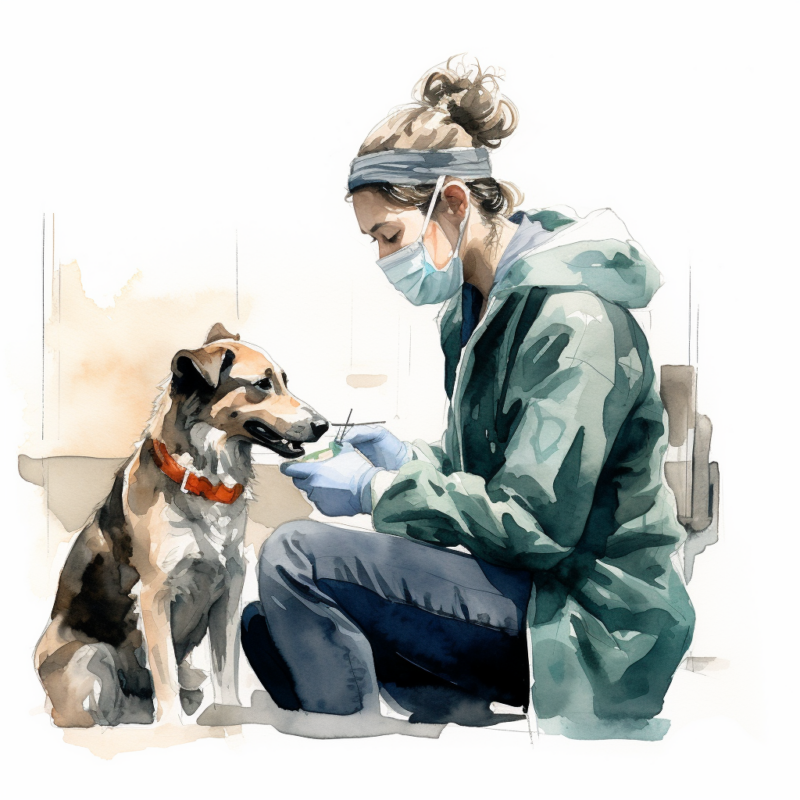Preventing Dog Diseases from Spreading to Humans
Are you aware that certain diseases, known as zoonotic diseases, can transfer from our beloved pets to us? Indeed, our adorable canine companions, while offering unending joy and companionship, can sometimes harbor infectious diseases that have the potential to affect humans. As much as the bond we share with our furry family members is precious, it’s equally vital to recognize these health risks for the safety of all household members.
This blog post delves into the captivating yet crucial sphere of zoonotic diseases, particularly those that can transmit from dogs to their human caretakers. Diseases like kennel cough and tick-borne diseases are just a few examples. We also highlight a potentially fatal zoonotic infection known as rabies, and its prevention is a key aspect of disease control.
We aim to increase your understanding of these diseases, their impact on your health, and, most importantly, what you can do to prevent dog diseases from spreading. Knowledge of these risks and effective management strategies form another integral part of responsible pet ownership.
Let’s equip ourselves with this vital knowledge, not just for us but also for our fur babies’ well-being. This includes being aware of potential risks such as animal bites, which could transmit diseases like cat scratches or lead to encounters with a rabid animal. Awareness and preparedness are the best tools for protecting our entire family.
What is Zoonotic Disease?
Zoonotic diseases, also known as zoonoses, can be passed from animals to humans. Harmful germs like viruses, bacteria, parasites, and fungi cause them. These diseases can cause many illnesses in people and animals, ranging from mild to serious illness and even death in some cases.
Animals can sometimes appear healthy even when carrying germs that can make people sick. Depending on the disease, an animal might not show symptoms but could still be carriers. Zoonotic diseases can be spread to humans in a variety of ways. For instance, they can be contracted through direct contact with the animal or its droppings, consuming contaminated food or water, being bitten by an infected insect, or by the animal’s environment.
A few well-known examples of zoonotic diseases include Rabies, Lyme disease, Salmonellosis, and Leptospirosis. Some zoonotic diseases are more common in certain types of animals. For instance, birds often carry Avian Influenza (Bird Flu), while rodents can carry Hantavirus.
While anyone can contract a zoonotic disease, people with weaker immune systems, like the very young, the elderly, pregnant women and people with immune system disorders, are at a higher risk. Because our pets are part of our families and often live in our homes, share our lives and sometimes even our beds, they can, unfortunately, be a source of zoonotic diseases. Practicing good pet hygiene and regular veterinary care is crucial to minimize this risk.
What is the Process of Germ Transmission Between Animals and Humans?
The transmission of zoonotic diseases from animals to humans can occur through various routes, depending on the specific disease. Here’s a simplified explanation of some of the most common modes of transmission:
- Direct Contact: Direct contact happens when humans touch the bodily fluids of an infected animal, such as blood, urine, saliva, or feces. This can occur during petting, grooming, or handling of the animals. It’s also possible to get infected through a bite or scratch. For instance, Rabies is a well-known zoonotic disease that can be transmitted through a bite from an infected animal.
- Indirect Contact: Indirect contact involves contact with areas where animals live and roam or objects or surfaces that an infected animal, such as water bowls, cages, or bedding, has contaminated. A good example of this is Leptospirosis, which can be transmitted when humans come into contact with water, soil, or food contaminated with the urine of infected animals.

- Vector-borne: This happens when a person is bitten by a “vector” like a tick, flea, or mosquito that carries the disease from an infected animal. Lyme disease is an example of a vector-borne zoonotic disease, which is spread to humans through the bite of infected ticks.
- Foodborne: Diseases can also be contracted through eating or drinking something unsafe, such as unpasteurized milk, undercooked meat, or unwashed fruits and vegetables contaminated with feces from an infected animal. A common example of foodborne zoonotic disease is Salmonella, which can be contracted from eating undercooked poultry or eggs or handling pet reptiles like turtles.
- Airborne: Although less common, some diseases can be spread through the air in specific conditions. For example, certain forms of Influenza or Psittacosis (a disease from infected birds) can be transmitted to humans through the air.
Understanding these modes of transmission is important as it helps implement effective strategies to prevent the spread of zoonotic diseases. It is always a good practice to wash hands thoroughly after handling animals, ensure that pets are regularly checked and vaccinated by a vet, and take care while handling or preparing food.
Who is More Susceptible to Severe Illness From Zoonotic Diseases?
Certain groups are at a higher risk of serious illness from zoonotic diseases due to factors that may weaken their immune systems or make them more susceptible to infection. These groups include:
- Young children
- Elderly people
- Pregnant women
- People with weakened immune systems
- People with pre-existing medical conditions
To minimize the risk of zoonotic diseases, people in these high-risk groups should take extra precautions, including practicing good hygiene, avoiding contact with sick animals or contaminated environments, keeping up-to-date on vaccinations, and seeking prompt medical attention if they suspect exposure to a zoonotic disease.
Diseases You Can Catch From Your Dog
Our four-legged companions, particularly dogs, bring immeasurable joy and loyalty into our lives. However, it’s essential to note that they can also inadvertently pass on certain diseases to their human owners. Here are some examples of zoonotic diseases which can spread from dogs to humans:
Rabies
Rabies, primarily associated with rabies cases in older dogs, is a viral disease-inducing brain inflammation. It’s typically transmitted via the bite or scratch of an infected pet or a wild animal. Symptoms might take weeks or months to manifest in humans, ranging from general weakness and fever to anxiety, hallucinations, and hydrophobia. Once symptoms appear, rabies is nearly always fatal.

Rabies is a severe and fatal viral infection that affects the central nervous system of dogs and other mammals, including humans. The virus is primarily transmitted through the bite of an infected animal, as the virus is present in its saliva. However, Rabies can also be transmitted through scratches or contact with infected saliva on broken skin or mucous membranes.
In dogs, the disease progresses through several stages, including a prodromal phase with behavioral changes, a furious phase characterized by aggression and hyperactivity, and a paralytic phase leading to weakness, paralysis, and death. Rabies is a zoonotic disease that can be transmitted from dogs to humans, making it a significant public health concern. Vaccination and responsible pet ownership are crucial in preventing the spread of rabies.
Lyme Disease
Lyme Disease, primarily transmitted through ticks, is a bacterial infection that can lead to serious health issues if untreated. Symptoms can include fatigue, fever, and joint aches, among others. Early treatment can effectively clear the infection and prevent complications.
Leptospirosis
The Leptospira bacteria cause leptospirosis and can spread through contact with urine from infected animals, including domestic and farm animals, or through contaminated water, soil, or food. This disease presents a range of symptoms, from fever and muscle aches to more severe complications such as liver failure or meningitis.
Campylobacter Infection
Campylobacter Infection is a bacterial illness that causes digestive distress in humans. It’s often contracted from undercooked poultry or cross-contamination. Less commonly, it can be acquired from contact with feces from infected pets.
Salmonellosis
Salmonellosis is a bacterial infection in dogs caused by the Salmonella species and can affect many animals and humans. This intestinal parasite can cause symptoms like diarrhea, fever, and abdominal cramps in humans. It’s usually contracted from contaminated food, but contact with feces from an infected pet is another transmission mode.
Giardia
Giardia is a microscopic parasite that causes a diarrheal illness known as giardiasis. Symptoms may include diarrhea, gas, greasy stools, stomach or abdominal cramps, and dehydration in humans. Not everyone infected with Giardia becomes sick; some can carry the parasite without showing symptoms.
Ringworm
Ringworm is a fungal infection that appears as a circular, red, itchy rash on the skin or the scalp. It’s spread through direct contact with an infected animal or person or by touching an object or surface that an infected person or pet has recently touched. Ringworm can be treated with antifungal medications.
Toxocariasis
This parasitic infection happens when humans accidentally ingest the Toxocara roundworm’s eggs, often found in contaminated soil or dog feces. Children are particularly at risk. Symptoms may include fever, fatigue, cough, loss of appetite, and abdominal pain. Severe infections can cause vision loss or neurological problems. Treatment typically involves medications to kill the parasites.
As always, prevention is key. Maintain good hygiene habits, regularly de-worm and vaccinate your pets, avoid contact with unknown animals, and ensure proper cooking and handling of food to reduce the risk of these diseases.
Protect Yourself From Zoonotic Diseases
Prevent dog diseases from spreading involves practicing good hygiene and responsible pet care. Here are several important measures you can take:
- Wash Your Hands Regularly: Always wash your hands thoroughly with soap and water after handling animals, cleaning up animal waste, or caring for pets. This is especially important before eating or preparing food.
- Avoid Direct Contact with Animal Feces: This is crucial, as many zoonotic diseases can be spread through animal feces. Always use a bag or tool to clean up after your pets and dispose of their waste appropriately.
- Regular Vet Check-Ups and Vaccinations: Ensure your pets are regularly examined and vaccinated by a vet. They should also be regularly dewormed and kept free from fleas and ticks.
- Avoid Feeding Raw Food to Pets: Raw food can carry pathogens that cause zoonotic diseases. Stick to high-quality, well-cooked commercial pet foods.
- Prevent Pets from Drinking Contaminated Water: Make sure your pets have access to clean drinking water and prevent them from drinking from puddles or stagnant bodies of water where pathogens may be present.
- Use Personal Protective Equipment (PPE): If you are handling animals professionally or dealing with sick pets at home, always use appropriate PPE such as gloves and face masks.
- Educate Yourself and Your Family: Understand the risks of zoonotic diseases, and educate your family members, especially children, about how to interact safely with animals.
- Properly Cook and Handle Food: Avoid cross-contamination of raw and cooked foods to prevent foodborne zoonotic diseases. Always cook meat to the recommended internal temperature.
- Avoid Close Contact with Wild or Unknown Animals: Wild animals or unfamiliar pets can carry zoonotic diseases. It’s safer to appreciate them from a distance.
Remember, while pets can potentially transmit diseases, the health benefits of pet ownership far outweigh the risks. Awareness and appropriate preventive measures can ensure your relationship with your pets remains healthy.
Keep Your Pet Safe from Diseases
Just as you would take precautions to shield yourself from zoonotic diseases that can spread from animals to humans, you can also adopt measures to maintain the health of your pets, particularly domestic pets such as dogs, and protect them from general illnesses:
Regular Vet Visits
Arranging systematic appointments with your vet—typically once a year for most pets—is fundamental to disease prevention and maintaining healthy dogs. Regular checkups can help spot health complications before they escalate. These visits usually involve blood tests, urine tests, and checks for prevalent conditions related to your pet’s breed or age group.

Vaccinations
Vaccinations play a pivotal role in your pet’s health, protecting them against severe diseases such as rabies and distemper and reducing chances of human infection. The nature and regularity of vaccines will differ based on your pet’s age, lifestyle, and risk factors. Your vet will recommend the most suitable dog vaccination schedule for your pet.
Parasite Control
Parasites like fleas, ticks, and heartworms can cause significant health issues in pets, from itchiness and discomfort to serious conditions like Lyme disease. Regularly administered topical or oral preventatives offer the best defense against these threats. Your vet can recommend the most suitable products according to your pet’s size and lifestyle.
Balanced Diet
Depending on age, breed, size, and health status, pets’ nutritional requirements vary. High-quality pet food can help maintain a healthy weight, promote a glossy coat, and strengthen the immune system. Your vet can provide advice on the optimal diet plan for your pet.
Regular Exercise
Regular physical activity is vital to help maintain your pet’s healthy weight, warding off conditions like diabetes and arthritis. It also aids digestion, minimizes destructive behavior, and promotes overall well-being. Take your dog for regular walks or play sessions to keep them active.
Dental Care
Regular teeth brushing using pet-friendly toothpaste can prevent plaque buildup, which could lead to painful dental diseases and other systemic health problems. Periodically, professional cleanings by your vet may also be necessary.
Safe Environment
Create a pet-friendly home environment. Keep potentially harmful foods, cleaning supplies, and small objects out of your pet’s reach. Secure your yard to prevent your pet from escaping or coming into contact with potentially harmful animals or plants.
Grooming
Routine grooming comprises brushing your pet’s hair, trimming nails, and bathing. Besides maintaining a clean coat, grooming provides an opportunity to inspect for any skin abnormalities, parasites, or changes in your pet’s body.
Avoid Exposure to Sick Animals
Restrict your pet’s interaction with unfamiliar animals, especially those displaying signs of sickness. Pets, like dogs that come into contact with ill animals, are at an increased risk of developing diseases they may carry.
Spay/Neuter
These procedures prevent reproductive diseases and certain types of cancer and decrease behavioral issues linked with mating, such as aggression or wandering tendencies.
Scheduling regular checkups and taking these precautions help protect your pet and ensure a happy, healthy life while protecting your family from potential zoonotic diseases. Remember, disease prevention in pets is as crucial as in humans since many diseases can spread from animals to humans.
Frequently Asked Questions
Disclaimer: The information provided on this veterinary website is intended for general educational purposes only and should not be considered as a substitute for professional veterinary advice, diagnosis, or treatment. Always consult a licensed veterinarian for any concerns or questions regarding the health and well-being of your pet. This website does not claim to cover every possible situation or provide exhaustive knowledge on the subjects presented. The owners and contributors of this website are not responsible for any harm or loss that may result from the use or misuse of the information provided herein.






